If you’re an avid Gran Turismo player or watched — or attended — the World Finals in Barcelona earlier this month, you’d have been hard-pressed to miss the launch of the new Genesis Vision Gran Turismo car.
Genesis Design North America’s senior chief designer John Krsteski and Gran Turismo series creator Kazunori Yamauchi pulled the covers off the sleek and extremely orange hypercar during the Manufacturers Cup live stream on Saturday December 2, right in the middle of the arena.
GTPlanet was granted unprecedented access to the car and its designers courtesy of Genesis Motor Europe. We spoke to Krsteski for a guided tour of the car’s exterior, while Chris Ha — senior interior manager — talked us through the vehicle’s cabin.
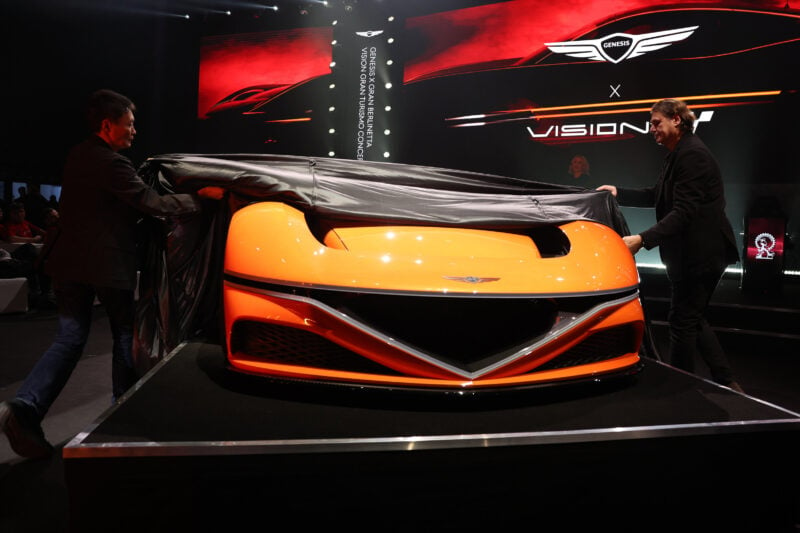
Genesis Vision Gran Turismo: Exterior
One of the things that struck us particularly was that — while a number of Vision GT cars can be on the wild side — the Genesis design appeared to have a lot of plausibility about it.
“We wanted to, because everything we do we always want to, make sure there’s a level of feasibility and realism that we bring to it, and it’s not something that’s maybe just a fantasy,” said Krsteski. “So with this, proportionally the centerline of the car, we worked with the packaging engineer to make sure that we had the placement of the engine in the front adequately placed relative to the cockpit and same time being able to put the battery power in the rear.”
It’s not just the vehicle packaging either, with the car sporting a number of interesting lines and aerodynamic solutions — and we were curious how the VGT’s design process worked with regards to aero.
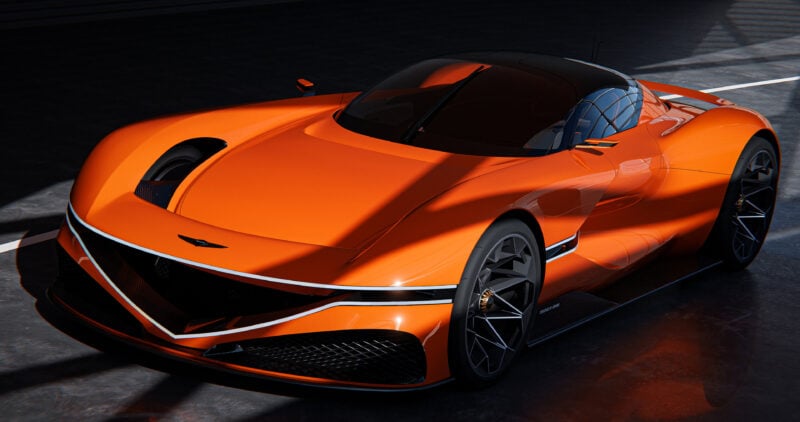
“A lot of the designers will freestyle something that they think works and looks cool, and then they quickly realize that okay, wait a minute, that may look cool but it actually is horrible for aero.
“So then we get the results back and they show us the analysis; the aero team is really great and like, ‘you can hold on to kind of what you’re doing but you need to adjust this by you know, three degrees’ and then ‘you need to add crease line through that section and to help control some of the way the air flows through there’.
“It’s a really finite process working with the aero team to try to at least take what we’ve initially started design-wise and then be able to refine it. There’s certain things and, you know, the aero team, they’re like artists in a lot of ways, because they know exactly where you could put a little blade or a little inlet and what you do with underneath the car as well.”
“It’s one of those things, too; you want function but not at the expense of beauty. And then you don’t want it to just be beautiful and not functional. So that constant negotiation between the groups was vital to the process.”
That, in part has resulted in things like the front wing section, with the pass-through under the upper nose, and similiar elements at the rear.
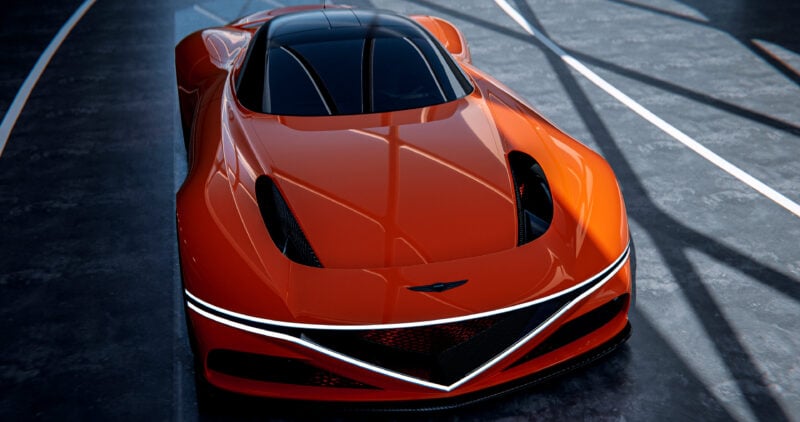
“A lot of the air that flows through [the front duct] creates the downforce needed for the front. At the same time, going up over there, and then the outlets end on the inside of the wheels for a lot of the the braking and everything else to vent out as well.”
These sections did cause something of a headache for the initial clay model, with the rear cut-outs being particularly difficult to sculpt with the usual techniques — resulting in a more modern solution.
“I can tell you, the clay modelers, when we were working on that, when we milled it out, it’s funny because we couldn’t get the mill to go inside of that pocket area. And I’m like, ‘okay, we need to cut that out’. ‘What do you mean we need to cut it out?’. ‘We need to cut that out because we need the tail lamps to go through.’.
“That’s when we were mixing a lot of 3D printed parts into the clay model itself to try to get it to hold its surface and then make sure everything still transitioned beautifully. When we had the fender coming through, we literally had three different types of spoilers that we 3D printed and we’re plugging into the clay and then checking the sections and everything else and then working it back into the surface.”
“I mean, we milled this car out probably half a dozen times. And each time, looking at it, at some point you need to get in there and let some of the hand work take over the digital process to get to that level of finesse and surface and section; the way the lights would reflect where the sections feel above the wheel, versus on the inside part of the wheel, versus the backside of the wheel, and how those sections transition is such an art.”
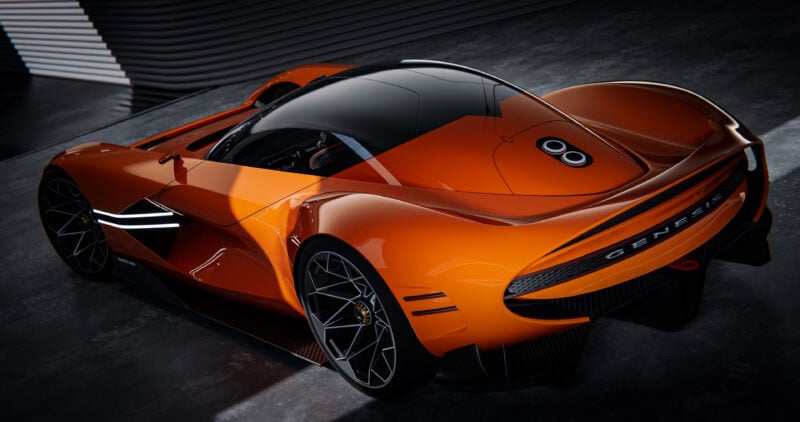
There’s certainly a lot going on in the finer details of the car too, with what Genesis refers to as a ‘virtual parabolical tensioned theory’ design that features on its road-going models.
“One of the things that early in the sketches when we saw the designs, we were like, oh wow, that has this quality where it feels like the car is ready to leap forward. And then at the same time, just talking through it, we’re like it’s a lot if you imagine like an Olympian, someone running track, and when they get into position.”
“They’ve got their legs, they’re flexed, they’re tight, they’re ready to launch, because they’re putting all that energy and power in their legs to be able to take off immediately. And we thought, you know what, we need to capture the essence of that somehow in this rear three-quarter fender, and with wheels and everything else, to feel, to give you this impression that it’s ready to leap forward because of the parabolic thrust in the front fender.
“And then that’s why we kind of pushed and put tension into that to make it feel like it’s almost almost being pulled back to be launched forward.”
“Organic shapes are probably the hardest to develop from the standpoint of it can look organic and friendly — it can look, you know, fun. This is definitely a fun car, but in a different way. And it needs to have tension and attitude and that dynamism that you want, because obviously that translates to the driver, feeling like they’ve got the confidence reinforced to go out there and take on anything.”
Another eye-catching feature of the Genesis is those large, multi-spoke wheels — which Genesis designed in-house too.
“Wheel design is such a challenging thing to do, and especially because there’s so many amazing designers out there — and people who specialize in wheel design as well.
“We did all our own wheel designs in-house with our team, and it’s the same designers that are working on the whole exterior. Because I think that the, the designer who’s doing the exterior has a feeling for the kind of wheel that he wants on the car. And I’m sure there could be several other designs that may look good on here, but I think that that first initial read of what the wheels should look like comes from the design of the car.
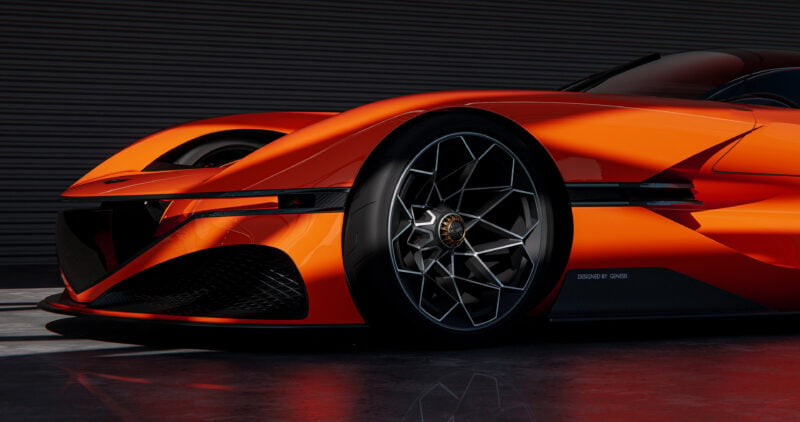
“There’s so many different… there are trends in the wheel design and sometimes you get into the solid, spoke wheels — you know, who doesn’t like a good five spoke, right? — but with something like this, we really wanted to create sort of a reinterpretation of what you would say a mesh wheel in racing or even a honeycomb type of wheel, but proportionate to the scale that was adequate for, for the car.”
Maybe the most obvious part of the car of all is that extremely striking paint: Magma Orange, which made its debut on the GV80 Coupe Concept earlier this year. It symbolises not only Korea’s volcanos and culture, but the literal ‘genesis’ of volcanic activity.
“We love it! We’re gonna keep pushing to see as much of this color as we can on, as many cars as we can. And it’s amazing too because the whole inspiration of it was from volcano activity and the magma and everything else there and, you know, it goes through so many different colorations of orange in that process.”
“You know, because you could always go either to yellow, you could always go to red, but finding that right orange that feels representative of magma under different lighting conditions was a fun challenge.”
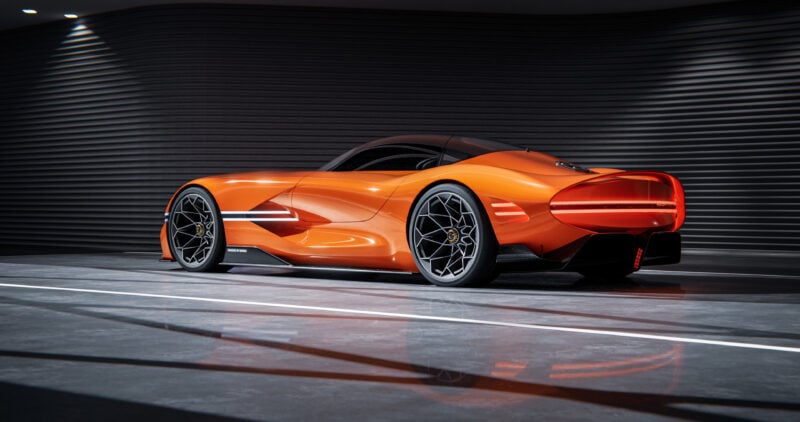
Key to Genesis though is the fact it, despite being such a departure from its normal sedan and SUV offerings, the VGT still looks like a Genesis, and that in part comes down to the continuation of the signature ‘two lines’.
“It’s one of those things that when we first came with our Genesis identity — the story on the wing badge becoming our two line signature — and then that two line started at the front… but it’s like, alright, well, what’s keeping it from going further and further and further? And then literally wrapping it around the whole, whole front clip of the car. Yeah, we thought, you know, why not push it to that extreme?
“It definitely allows us to build equity in a brand. Especially a new brand, you want positive reinforcement to repetition in that sense. I can’t tell you how often we negotiate internally as, as we’re, you know, coming up with new proposals and we’re still challenging that two line signature.
“We’re always like, okay, well, where does the two line go next? And then it goes a little too far and you’re like, you know what? Pull it back. We need to hold on to our signature and the equity that we’re building into it. And then that’s when you realize you have something special.”
Genesis Vision Gran Turismo: Interior
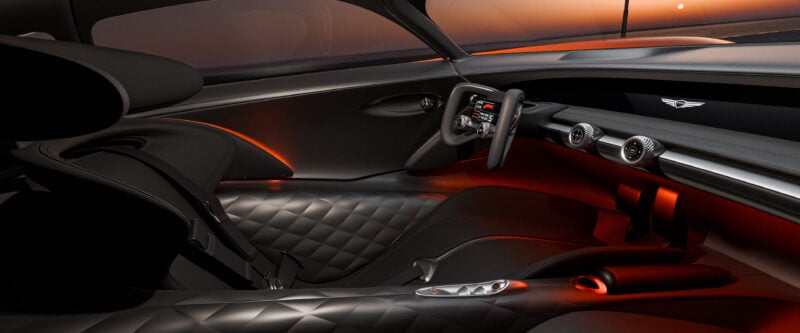
We were also fortunate enough to be granted exclusive access to the vehicle’s cabin.
While production Genesis models are pretty plush and well-appointed, the VGT is a more spartan environment, obviously designed for motorsport but still with Genesis touches.
“What we’re always doing in Genesis is designing around the user,” says Ha. “You know, we’re always trying to make it the most comfortable, the most functional at the same time — and obviously aesthetically pleasing or beautiful.
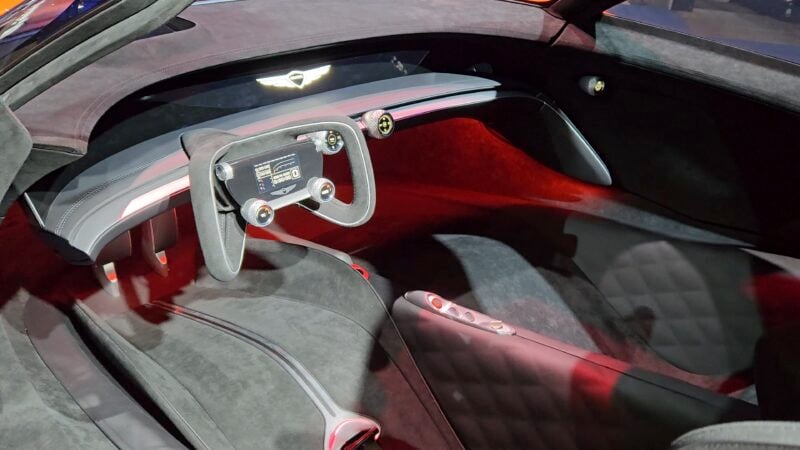
“For us, in every project, we’re always approaching it from the driver out. So that’s the most important: as long as he or she is hitting those ergonomic points — because ergonomics is like king for us. It’s got to be number one. If it doesn’t feel right we scrap it.
“That’s kind of what drove the theme; we put the driver in there and then you see these forms being sculpted around them. So this is where the sculpture of the monocoque comes from.”
There’s just one seat in the cabin, which does feature signature Genesis quilting and plenty of Alcantara suede, but ultimately it’s a necessity — to protect and guide the driver’s body towards the controls.
“It’s kind of like this quilted monocoque, so that it really surrounds the driver. Within there, you see the seat really growing out of it, so you have the shoulder bolster growing out, the head restraints, and then the lower bolster for the legs. They all point really towards all the instrumentation.”
This too shows the ‘two line’ philosophy, with a ridge down the center of the driver’s seat in a neat detail.
“We hide it here and there! Sometimes subtly, sometimes in your face. You can kind of see it subtly in the air blade [forward air vents] so that two lines really kind of wraps around the driver.”
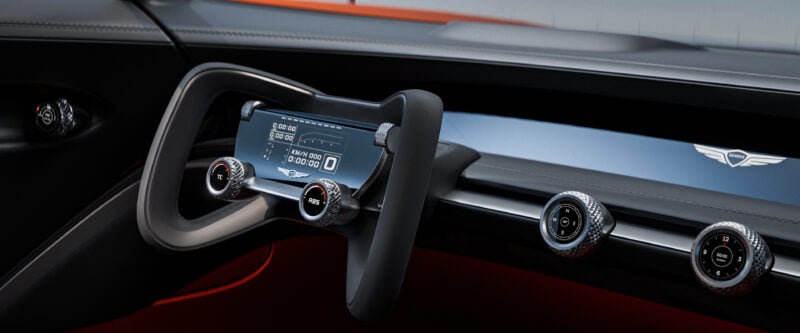
PlayStation gamers should instantly recognize the car’s steering wheel, which has been designed to resemble the famous DualShock (now DualSense) controller — the basic format of which has barely changed in over 20 years.
“That was really fun! I mean, actually that was one of the first things we gravitated to was like, what if we used a controller as inspiration? It would be really cool.
“We did a lot of test prints — 3D printing — just to make sure the ergonomics are feeling right. I think we had, like, probably six different iterations to get it to feel comfortable.”
Of course the wheel features an information screen in the center, as well as control dials and thumb wheels finished in the classic Genesis knurled aluminum.
“This kind of diamond knurling is something that we developed for the production models and it’s really to give you the precise feeling — that grip so you can kind of turn it precisely, almost like high end audio equipment. When you turn that volume up, you know, you feel this nice torque; it’s very tactile.”
The interior design of the VGT also employs the Genesis brand’s ‘beauty of white space’ design philosophy, inspired by minimalist principles.
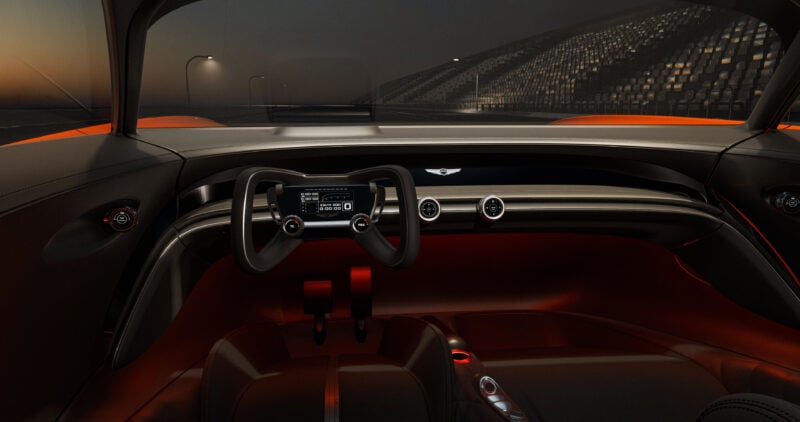
“The beauty of white space is challenging, because we’re not trying to add things for excitement. It’s all very purposeful. So when you look at the interior and all the lines, you see that they have purpose.
“For me personally, I like how all the lines are orchestrating together and that kind of dashboard really coming to you. It’s almost like it’s levitating and surrounding you. This is where I feel something a little bit special, which maybe you can’t see in the pictures.”
Visibility is a key component of the design too, with Genesis employing VR in the design process to ensure everything is where it needs to be.
“Visibility, first and foremost, through the actual transparencies and then through the screen — the dynamic display — is something that we really wanted to emphasize.”
Krsteski also points out an exterior detail informed by the use of VR in the design process, which some fans might have spotted in the trailers.
“Originally in the design we had a camera that was on the shoulder or in a small mirror camera on shoulder. When we were sitting inside the cockpit and looking out in the position of where we had the mirror there really felt like it wasn’t positioned right.
“So we went to the cameras and placed it there and actually took the mirror off the shoulder. If you notice, even some of the press shots, we still have some that have the mirror and some that don’t have the mirror.”
Genesis Vision Gran Turismo: Future
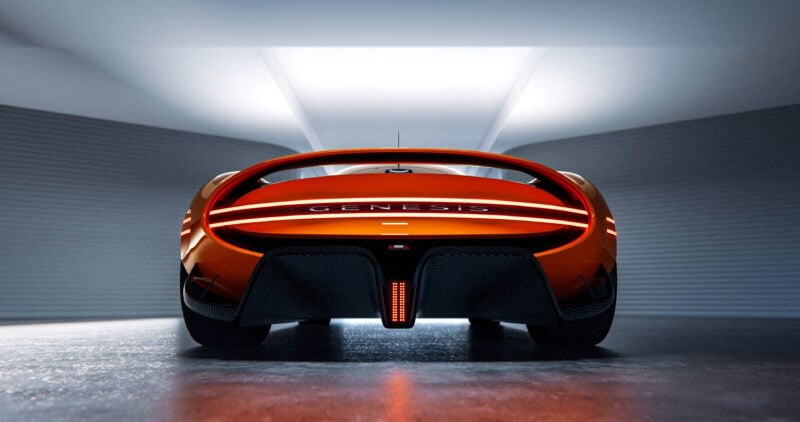
Perhaps the most notable aspect of the car as a whole is that the design is not too distant from being production-ready.
“I mean, we never know if that’s a possibility or not,” said Krsteski. “We never know the momentum, you know, the timing of everything. But I always feel that from a design perspective, if you could bring it to a level of believability in its design and take all the considerations in place, if the stars align and you are able to move forward with this and turn it into an actual production program, then that’s not going to be a huge tear up to your design.
“What happens sometimes, you put this sort of dream image of what you want out there and then put the precision of engineering and everything else into it. Then when it actually does come out in production you hear about how the show car looked better. Because everyone loves to compare the concept car to the production car.”
While Genesis has never made a car of this type before, Krsteski believes that concepts of this type could kick-start the brand’s desire to create one.
“They’re incredible communication tools because we may believe in it, but in any organization maybe 100 percent of the group doesn’t understand it until you can actually materialize it for them.
“Sometimes you have to really lead the way and show them that no, it is a possibility. And through something like this, through exercises like this, obviously with the partnership with Gran Turismo you start to plant that seed. Then let that catch momentum and see how far it can go.”
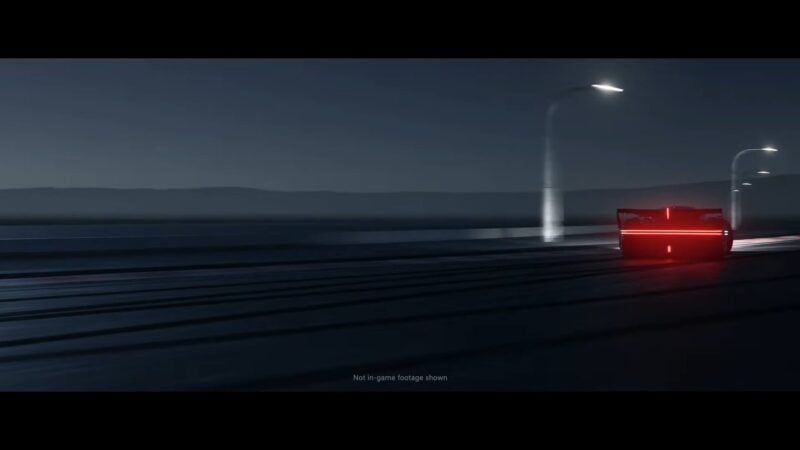
Potentially it could go very far; some may have noticed a glimpse at the very end of the video revealing that a second version of the vehicle with a large rear wing was briefly visible. Could it preview a racing model of the car — or a future hypercar entry for the group which has been successful in World Rally recently?
“Very astute! We figured we’d put in a little teaser of something in there, so…. I don’t know. I can’t say anything more than that. There’s such a high ceiling the possibility that, you know, hey, let’s see how far we can push it!”
See more articles on Genesis and Vision Gran Turismo.










